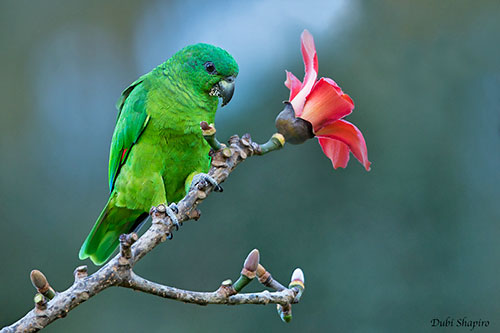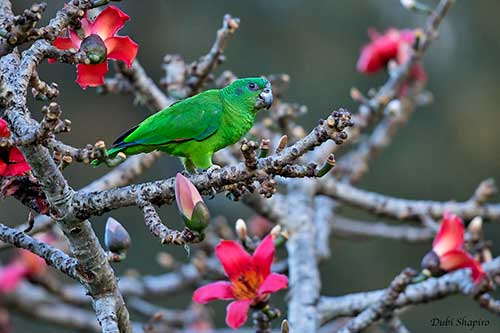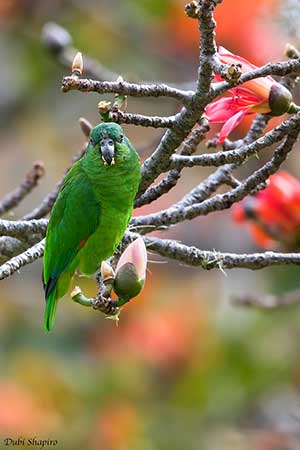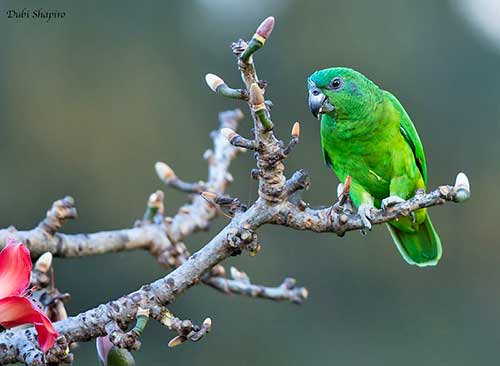
Fr: Amazone verte
Ang: Black-billed Parrot
All: Rotspiegelamazone
Esp: Amazona Jamaicana Piquioscura
Ita: Amazzone becconero
Nd: Jamaica-amazone
Sd: svartnäbbad amazon
Photographer:
Dubi Shapiro
Dubi Shapiro Photo Galleries & Dubi Shapiro's Pictures on IBC
Text by Nicole Bouglouan
Sources:
HANDBOOK OF THE BIRDS OF THE WORLD vol 4 by Josep del Hoyo-Andrew Elliott-Jordi Sargatal - Lynx Edicions - ISBN: 8487334229
PARROTS OF THE WORLD – An Identification Guide – by Joseph M. Forshaw – Princeton University Press – ISBN 0691092516
BIRDS OF THE WEST INDIES – by Herbert Raffaele, Kristin Williams et Tracy Pedersen – Helm – ISBN: 9780713649055
Wikipedia, the free encyclopaedia
Black-billed Amazon
Amazona agilis
Psittaciformes Order – Psittacidae Family
INTRODUCTION:
The Black-billed Amazon is endemic to Jamaica. It is smaller than the Yellow-billed Amazon and it has a dark bill.
It frequents moist limestone forests and their edges, mainly at mid-elevations. It typically feeds on fruit, berries, seeds, buds and blossoms, and forages high in forest canopy. It is sometimes considered a pest for cultivated crops. It nests in tree holes and both adults share most of the nesting duties.
The Black-billed Amazon is locally common in undisturbed areas, but the population is slowly declining due to habitat loss and predation at nest by snakes. The species is currently listed as Vulnerable.

DESCRIPTION OF THE BIRD:
Biometrics:
Length: 26 cm
Weight: 178-220 g
The Black-billed Amazon has green plumage overall, although the underparts are paler, mostly yellowish-green, including the undertail-coverts.
On the wings, the primary coverts are red. The primary flight-feathers are bluish with darker tips, whereas the secondaries are green and distally dark blue. The tail is green with red bases to outer rectrices and blue edges.
The head is green with some red flecks on the forehead. The neck feathers show slightly darker edges giving scaled effect. The male has dark ear patches.
The bill is grey with paler base. The eyes are dark brown, surrounded by dark grey eyering. Legs and feet are greenish-grey.
The female resembles male but she has some green primary coverts instead of red.
The juvenile has all primary coverts green.
RANGE:
The Black-billed Amazon is found in Jamaica where it is fairly common in mount Diablo and Cockpit Country. It is scarcer in E Jamaica.
HABITAT:
The Black-billed Amazon frequents the wet limestone forests up to 1,600 metres of elevation in hills and mountains. It can be seen at forest edge too, foraging in cultivated areas and plantations.

CALLS AND SONGS: SOUNDS BY XENO-CANTO
The Black-billed Amazon in flight produces a bugling “tuh-tuk”. When perched, it gives a growling “rrak” or “muh-weep”. We can also hear a sharp screech.
The calls are higher-pitched than those off the Yellow-billed Amazon.
BEHAVIOUR IN THE WILD:
The Black-billed Amazon feeds on fruit, berries, nuts, seeds, buds and blossoms, and also takes cultivated plants such as papaya, mango, cucumber and maize.
It forages high in forest canopy, but also in middle to upper stages of the forest. Flocks of more than 30 birds often gather at localized food sources.
The communal nightime roosts shelter large numbers of birds. They leave the roosts after loud calling at sunrise and disperse to their feeding areas. They rest in the middle of the day and then, they feed in mid-afternoon and return to the roosts at dusk.
The Black-billed Amazon rarely allows close approach, and if disturbed, it becomes silent before to fly off while uttering a loud screech.
It becomes highly vocal when breeding, and both mates call loudly in order to advertise the nesting territory.
Some courtship displays are known, but they differ from those of other amazons. The male is described charging at the female and then, swaying form side to side with stiff-legged awkward motion. It may even jump over the female. She solicits food from her mate which transfers it by regurgitation.
This species nests typically in natural cavities like holes in trees or hollow limb. Both adults share most of the nesting duties.

The Black-billed Amazon performs local wandering in search of food, and the populations will move to abundant food sources. But they remain in Jamaica.
It flies with shallow wingbeats below the plane of the back.
REPRODUCTION OF THIS SPECIES:
The breeding season takes place between March and July/August.
The Black-billed Amazon nests in cavities such as a hole in tree about 18 metres above the ground, hollow limbs, and old woodpecker hole and also at base of bromeliads.
The female lays 2-4 white eggs and incubates alone during 24 days, while the male brings her food. During the incubation, the male roosts within 50 metres from the nesting tree. It can be heard calling softly before leaving the roost for the first feeding of the morning. When it returns to the nest, it calls to attract the female, a soft series of “muh-weeps”. She leaves the nesting cavity followed by her mate. They exchange food between 10 and 100 metres from the nesting tree.
Only two young are usually reared. They leave the nest about 8 weeks after hatching.
The Jamaican Boa is a predator and the main cause of mortality in chicks.
PROTECTION / THREATS / STATUS:
The Black-billed Amazon is threatened at nest by predation by snakes, but also by habitat loss caused by logging and bauxite mining. This species is also trapped for local consumption, but more rarely for illegal pet trade.
The population is roughly estimated to number 6,000/15,000 individuals and is slowly declining. The species is fairly common in undisturbed habitats.
The Black-billed Amazon is currently listed as Vulnerable.
